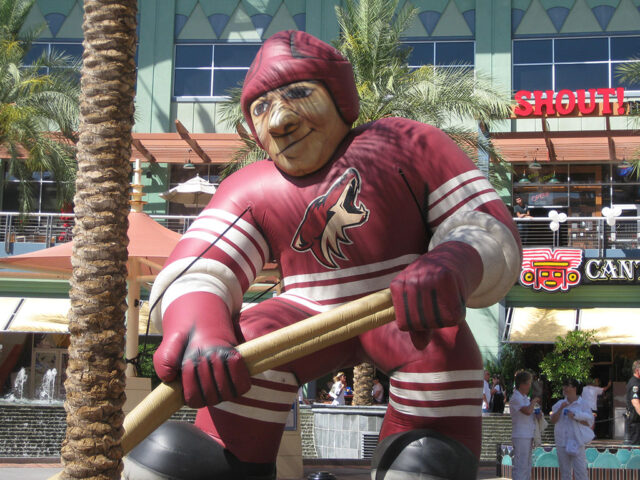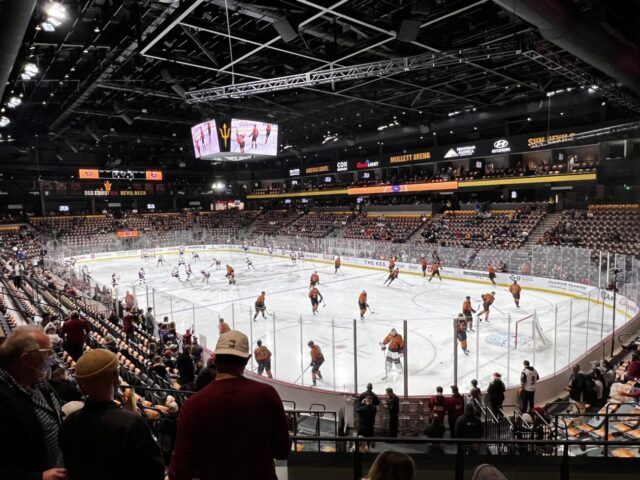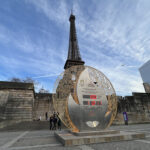The relocation of the Arizona Coyotes became complete this week, as the NHL franchise was officially sold and its move to Utah approved. The team will begin playing at Salt Lake City’s Delta Center next season, ending a star-crossed 28-year stay in the Phoenix area.
Rather than get into the myriad issues that led to this point, such as the Coyotes’ increasingly frustrating efforts to get a new arena built, or the business forces that caused the NHL to very quickly pivot toward allowing the team to relocate to Utah, let’s instead reminisce about what it was like watching hockey in the Valley of the Sun. (This is a sports travel site, after all.)
I’ve seen a lot of hockey in the Phoenix area over the years. I’m a die-hard Kings fan living in Los Angeles, but Phoenix might be the market in which I’ve seen the second-highest number of NHL games over the years.
I’ve seen games at all three of the arenas the Coyotes called home after relocating to Arizona from Winnipeg in 1996. All three had serious flaws, but all made for memorable experience in my hockey-watching life.
So to bid fond farewell to the Arizona Coyotes (for now, supposedly) following their relocation to Utah, here’s a look back at those venues, and what I remember of what it was like seeing live NHL hockey at each of them.
America West Arena: Coyotes’ formative years
Because my first job out of college required me to move to Arizona, I wound up visiting the Coyotes’ first home in Phoenix, to get my hockey fix on numerous occasions.
That arena is now called Footprint Center but was originally known as America West Arena. It’s the home of the NBA’s Phoenix Suns — and a pretty impressive home, at that. That’s because the arena was built specifically for basketball, and with basketball sight lines in mind.
So when the Winnipeg Jets first relocated to Arizona and became the Coyotes, that meant shoehorning a regulation hockey rink into an event space meant for a much smaller basketball court.
Anyone who remembers what happened when the New York Islanders tried playing games at the Brooklyn Nets’ Barclays Center for a few years knows how this worked out. Seats behind one net had an obstructed view and were sold at a deep discount, while the overhead videoboard was annoyingly off-center in relation to the ice.
Ironically, the arena in Utah to which the Coyotes are moving is also designed specifically for basketball, so it will be interesting to see whether they manage to avoid the inauspicious start there that they wound up experiencing in their relocation to Arizona.
Still, I have great memories of watching games at America West. I took my then-girlfriend, now-wife to her first hockey game there (that game, as she likes to remind me many years later, ended in a tie).
I also saw a game in which the Gin Blossoms, the Phoenix area-based rock band that at the time was at the height of its fame, played its hits from an upper-deck stage between periods.
And I watched multiple games of an epic seven-game playoff series between the Coyotes and St. Louis Blues, one that should’ve announced the arrival of a team that boasted players like Jeremy Roenick, Keith Tkachuk, Teppo Numminen and Nikolai Khabibulin as true contenders but instead ended in a disappointing 1-0 loss in overtime of Game 7.
A couple heady years of playoff appearances couldn’t mask the fact that the Coyotes had a serious arena problem, though. They seemingly solved it in 2003, when they moved to a new building in the Phoenix suburb of Glendale.
Jobing.com Arena: The Coyotes move to the ‘burbs
In 2003, the Glendale Arena was completed in a quickly growing western suburb of Phoenix. The arena would later become known as Jobing.com Arena and become part of an emerging district that included a mall and the Arizona Cardinals’ new home, now called State Farm Stadium.
Meanwhile, the Coyotes meandered through a period of futility that included having Wayne Gretzky as coach and a bankruptcy. But they eventually found their way back to the Stanley Cup playoffs in 2010, and two seasons later advanced all the way to the Western Conference final.
That’s where they would meet the Kings, who were putting together their own improbable playoff run. Game 1 of that series would be played in Glendale, and my wife and I made the road trip from Southern California so that I could see my first game at Jobing.com Arena.
I had had a previous taste of the White-Out, the playoff tradition the Coyotes inherited from the original Winnipeg Jets franchise, from my previous exposure to playoff games in Arizona. It certainly makes for a cool visual, even if a sizable contingent of black-clad Kings fans showed up to disrupt the aesthetic somewhat. (When my wife and I sat down, a Coyotes fan behind us immediately asked if he could have the white T-shirt draped across my seat, since I clearly had no need for it.)
The Kings, of course, spoiled the fun by winning all three games in Glendale to take the series in five games. To my delight, they would go on to win the Stanley Cup. Meanwhile, that Western Conference final appearance remains to this day the farthest the Coyotes franchise has ever advanced in the playoffs.
The Coyotes spent almost 20 years playing at Jobing.com Arena, later renamed Gila River Arena. I made a few more visits over the years for games and was always amused by how the game atmosphere seemed to cater to the snowbirds visiting Arizona as well as the Coyotes’ opponents.
For example, there was a time when Canadian favorite Tim Hortons had a small stand in the arena, which I always made a point to stop at for some Timbits and a hot cocoa.
But the arena’s location in the western suburbs of Phoenix, far from the affluent cities of Scottsdale, Mesa and Chandler in the East Valley, seemed to always be a crutch for the Coyotes. Eventually, a dispute over unpaid taxes led to an acrimonious parting between the team and city, and the Coyotes left for a substandard situation.
Mullett Arena: The Coyotes’ last resort
Leaving Glendale in the rearview mirror, the Coyotes set up shop for the 2022-23 NHL season at Mullett Arena, a 5,000-seat arena on the Arizona State University campus.
Newly built for the Sun Devils’ burgeoning Division I ice hockey program, the building was perfectly suited for the college atmosphere but woefully inadequate for the highest level of the pro game. Questions immediately followed about whether the Coyotes’ days in the Valley of the Sun were numbered.
While playing in such a small barn was undoubtedly a bad look for the Coyotes, I admittedly was intrigued by what kind of atmosphere I’d see there. So for the Kings’ first visit in the 2022-23 season, I made the trip to see for myself.
My first impression, of course, was clouded by the fact that it was a pretty expensive endeavor. The intimate venue meant that no seat in the regular seating bowl was more than about 20 rows for the ice, and all of those tickets were being sold at premium prices.
I bought seats at the end of the ice where the visiting team shoots twice, which was meant to be student seating at Arizona State games and thus was bleacher-style. But other than having no seat back, the experience itself was quite nice. A spirited mix of Coyotes and Kings fans took in the game, won by the home team in overtime.
The newness of the facility also stood out, with a fairly roomy concourse and brand-name food options that I wouldn’t have expected to see in such a small venue. The intimacy enhanced the game experience as well, as there was an easily accessible section on the event level in which fans could watch the Coyotes walk from their dressing room to the ice.
Still, this unique setup wasn’t meant to last. And when the Coyotes’ initiative to get a new arena built in Tempe failed at the ballot box in the spring of 2023, it appeared the franchise’s eventual departure would be a foregone conclusion.
As it turned out, the team’s commitment to give Mullett Arena another go this past season just delayed the inevitable. Still, the Coyotes’ relocation to Utah and desertion of what they had built in Arizona seemed to come together very quickly, leaving the fan base with little time to put together one last emotional farewell for the team’s final home game — one that included a final white-out.
With the relocation now official, we’re left to ponder the potential of the NHL’s new market in Utah, but we’re also left with memories of the Coyotes’ star-crossed Arizona tenure and a palpable sense of what could’ve been.
But for what it’s worth, I thoroughly enjoyed the experience of watching hockey in the desert, and I know many other NHL fans did as well.




 Edward de la Fuente | Itinerant Fan
Edward de la Fuente | Itinerant Fan
